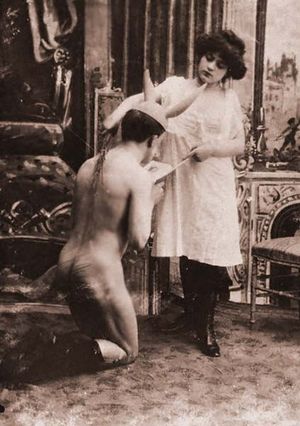Donkey cap: Difference between revisions
(Created page with "thumb|right|{{bc|Vintage F/M scene with a donkey cap}} {{header}} The '''donkey cap''' was the European variant of the dunce cap, common...") |
m (Text replacement - "18th century" to "18th century") |
||
| (4 intermediate revisions by the same user not shown) | |||
| Line 13: | Line 13: | ||
The delinquent boy has to sit on a wooden donkey, wearing a donkey cap and a signboard with a picture of a donkey, to be mocked by his classmates. The top of the illustration is a close-up of the donkey signboard. | The delinquent boy has to sit on a wooden donkey, wearing a donkey cap and a signboard with a picture of a donkey, to be mocked by his classmates. The top of the illustration is a close-up of the donkey signboard. | ||
Donkey masks for punishment were also used in late mediaeval and Renaissance schools, up to the 18th century. A 17th century German handbill[1] had the following related verse: | Donkey masks for punishment were also used in late mediaeval and Renaissance schools, up to the [[18th century]]. A [[17th century]] German handbill[1] had the following related verse: | ||
:"Eben also wann die Jugend, | :"Eben also wann die Jugend, | ||
| Line 31: | Line 31: | ||
:A donkey's head | :A donkey's head | ||
:For their money and bread | :For their money and bread | ||
:They will get the rod and stick | :They will get the rod and [[stick]] | ||
:For their honor shame and jeer | :For their honor shame and jeer | ||
:Until they say: May God have mercy". | :Until they say: May God have mercy". | ||
Latest revision as of 22:34, 10 August 2021
The donkey cap was the European variant of the dunce cap, commonly used as a psychological school punishment in the 18th and 19th century based on the principle of humiliation. It was a cap with "donkey's ears" to symbolize stupidity. The delinquent pupil had to wear the donkey cap either while standing in corner time or seated on a wooden donkey that stood for this purpose in the classroom.
The donkey cap has possibly evolved from a donkey mask that was put over a delinquent's head for punishment. In Antiquity, procunsul Eutropius in AD 389 reportedly punished petty thieves with a chastisement with the birch rod and the wearing of a donkey mask.
Donkey masks
School scene with a pupil wearing a donkey mask (Germany, 1488).
Illustration by Fritz Bergen titled "Schulstrafe" (school punishment).
The delinquent boy has to sit on a wooden donkey, wearing a donkey cap and a signboard with a picture of a donkey, to be mocked by his classmates. The top of the illustration is a close-up of the donkey signboard.
Donkey masks for punishment were also used in late mediaeval and Renaissance schools, up to the 18th century. A 17th century German handbill[1] had the following related verse:
- "Eben also wann die Jugend,
- Nicht will lernen Kunst und Tugend,
- Träget sie vor ihren Lohn
- Einen Eselskopf davon,
- Vor den Heller und den Weck,
- Kriegen sie die Ruth und Steck,
- Vor die Ehre Schand und Spott
- Das es heist: Erbann es Gott".
Translation:
- "Therefore if the youth
- Won't want to learn skills and virtue
- They have to wear for their meed
- A donkey's head
- For their money and bread
- They will get the rod and stick
- For their honor shame and jeer
- Until they say: May God have mercy".
Donkey boards
In the Netherlands, an ezelsbord ("donkey board", a signboard with the picture of a donkey) was hung around a "stupid" pupil's neck for punishment (see photo).
References
Source: http://www.fibri.de/texte/Wettlaufer_2008_Paedagogik.pdf
See also [ Shame ]
Chat rooms • What links here • Copyright info • Contact information • Category:Root
